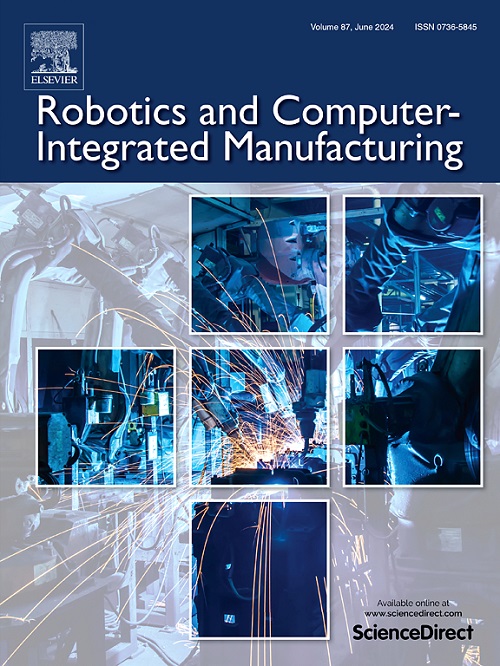Proposal of a complexity model for human-robot collaboration assembly processes
IF 9.1
1区 计算机科学
Q1 COMPUTER SCIENCE, INTERDISCIPLINARY APPLICATIONS
引用次数: 0
Abstract
Assembly complexity in manual processes has been widely addressed over the years in manufacturing-related literature. The concept of complexity indeed is linked to the cognitive and physical effort required on behalf of the human operator in completing the assembly process and is directly linked to the occurrence of process failures and inefficiencies. In the light of the introduction of novel technologies such as collaborative robotics such paradigm should be revised. This paper presents a proposal for a complexity model, i.e., “C![]() HRC model”, for Human-Robot Collaboration assembly processes. C
HRC model”, for Human-Robot Collaboration assembly processes. C![]() HRC model provides a multidimensional framework and a practical tool for analysing the complexity of collaborative assembly processes performed by humans supported by collaborative robots. In this situation, the collaboration with the robot may require an additional effort from the human operator, resulting in a more complex activity and thus more error prone. In this regard, the C
HRC model provides a multidimensional framework and a practical tool for analysing the complexity of collaborative assembly processes performed by humans supported by collaborative robots. In this situation, the collaboration with the robot may require an additional effort from the human operator, resulting in a more complex activity and thus more error prone. In this regard, the C![]() HRC model integrates insights from multiple disciplines to provide an overview of collaborative assembly complexity based on four layers: product complexity, assembly complexity, interaction complexity and collaboration complexity. The conceptual foundation of the C
HRC model integrates insights from multiple disciplines to provide an overview of collaborative assembly complexity based on four layers: product complexity, assembly complexity, interaction complexity and collaboration complexity. The conceptual foundation of the C![]() HRC model is thoroughly detailed and supported by a review of the relevant literature. Hence, the paper uses the complexity formulation proposed by Samy and ElMaraghy as a basis to provide a quantitative approach. The model is then applied to practical case studies to demonstrate its application and illustrate how it can enhance the understanding of effective human-robot collaboration. This provides process designers with a practical tool to support design and improve collaborative assembly processes.
HRC model is thoroughly detailed and supported by a review of the relevant literature. Hence, the paper uses the complexity formulation proposed by Samy and ElMaraghy as a basis to provide a quantitative approach. The model is then applied to practical case studies to demonstrate its application and illustrate how it can enhance the understanding of effective human-robot collaboration. This provides process designers with a practical tool to support design and improve collaborative assembly processes.
人机协作装配过程复杂性模型的提出
多年来,在与制造相关的文献中,手工过程中的装配复杂性已经得到了广泛的解决。复杂性的概念确实与人类操作员在完成装配过程中所需要的认知和体力劳动有关,并与过程失败和效率低下的发生直接相关。随着协作机器人等新技术的引入,这种模式应该进行修订。本文提出了一种人机协作装配过程的复杂性模型,即“CHRC模型”。CHRC模型为分析由协作机器人支持的人类协同装配过程的复杂性提供了一个多维框架和实用工具。在这种情况下,与机器人的协作可能需要人类操作员付出额外的努力,从而导致更复杂的活动,从而更容易出错。在这方面,CHRC模型集成了来自多个学科的见解,提供了基于四个层次的协作装配复杂性的概述:产品复杂性、装配复杂性、交互复杂性和协作复杂性。通过对相关文献的回顾,我们详细介绍了CHRC模型的概念基础。因此,本文以Samy和ElMaraghy提出的复杂性公式为基础,提供了一种定量方法。然后将该模型应用于实际案例研究,以演示其应用,并说明它如何增强对有效人机协作的理解。这为过程设计者提供了一个实用的工具来支持设计和改进协作装配过程。
本文章由计算机程序翻译,如有差异,请以英文原文为准。
求助全文
约1分钟内获得全文
求助全文
来源期刊
CiteScore
24.10
自引率
13.50%
发文量
160
审稿时长
50 days
期刊介绍:
The journal, Robotics and Computer-Integrated Manufacturing, focuses on sharing research applications that contribute to the development of new or enhanced robotics, manufacturing technologies, and innovative manufacturing strategies that are relevant to industry. Papers that combine theory and experimental validation are preferred, while review papers on current robotics and manufacturing issues are also considered. However, papers on traditional machining processes, modeling and simulation, supply chain management, and resource optimization are generally not within the scope of the journal, as there are more appropriate journals for these topics. Similarly, papers that are overly theoretical or mathematical will be directed to other suitable journals. The journal welcomes original papers in areas such as industrial robotics, human-robot collaboration in manufacturing, cloud-based manufacturing, cyber-physical production systems, big data analytics in manufacturing, smart mechatronics, machine learning, adaptive and sustainable manufacturing, and other fields involving unique manufacturing technologies.

 求助内容:
求助内容: 应助结果提醒方式:
应助结果提醒方式:


